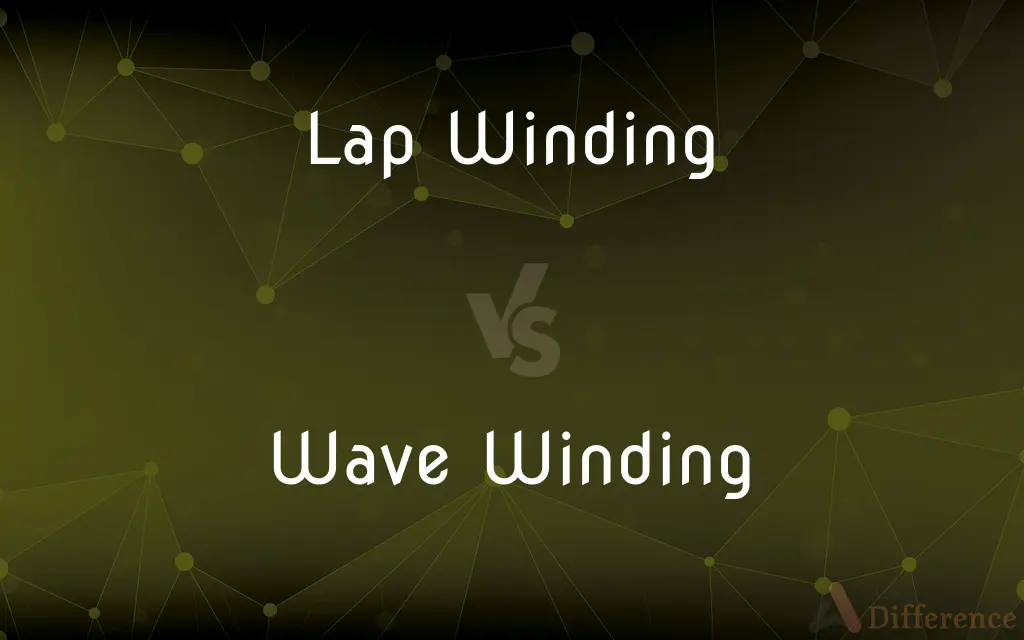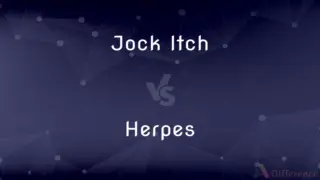Lap Winding vs. Wave Winding — What's the Difference?
By Tayyaba Rehman — Published on January 24, 2024
Lap winding is used for high current and low voltage applications, involving many parallel paths; wave winding suits high voltage, low current uses with only two paths.

Difference Between Lap Winding and Wave Winding
Table of Contents
ADVERTISEMENT
Key Differences
Lap winding, employed in electrical machinery, involves winding the wire such that it overlaps itself, creating multiple parallel paths, thus suitable for high current applications. In contrast, wave winding arranges the coils in series, forming a continuous wave-like pattern, ideal for high voltage, low current scenarios.
In lap winding, each coil is connected to its neighbor under the same pole, creating a redundancy that enhances reliability, particularly beneficial in high current scenarios. Wave winding, however, connects each coil to the one under the next pole, reducing the number of parallel paths and making it more efficient for high voltage requirements.
The complexity of lap winding lies in its numerous connections and parallel paths, making it more cumbersome to construct but effective for large, industrial motors. Wave winding offers a simpler design with fewer connections, making it easier to manufacture and more suited for smaller, high-speed machines.
Maintenance and repair of lap-wound machines can be more challenging due to their complex structure, but they excel in distributing current evenly. Wave-wound machines, with their simpler configuration, are easier to repair but may face uneven wear and tear due to the uneven distribution of current across the coils.
Efficiency in lap winding is optimized for high current, low-speed operations, commonly seen in heavy machinery and traction systems. Wave winding, conversely, is more efficient in high-speed, low torque applications, such as in generators and high-speed motors.
ADVERTISEMENT
Comparison Chart
Current and Voltage
High current, low voltage
High voltage, low current
Number of Paths
Many parallel paths
Two paths
Coil Connection
Coils connected under the same pole
Coils connected under the next pole
Complexity
More complex, many connections
Simpler, fewer connections
Suitable Applications
High current, low-speed machines
High voltage, high-speed machines
Compare with Definitions
Lap Winding
Suitability: Ideal for low voltage, high current applications.
We use lap winding in this generator due to its low voltage, high current design.
Wave Winding
A winding method: Continuous series connection for high voltage.
The wave winding in this generator optimizes it for high voltage output.
Lap Winding
Use in machinery: Common in heavy-duty industrial motors.
The lap winding in this traction motor provides the necessary torque for heavy loads.
Wave Winding
Use in machinery: Common in high-speed, low torque motors.
The wave winding is ideal for this high-speed drill due to its efficient high voltage performance.
Lap Winding
Complexity: More connections, complex design.
Repairing this motor is challenging due to its complex lap winding.
Wave Winding
Coil arrangement: Coils connected in a wave-like pattern.
The wave winding creates a continuous loop across all the poles.
Lap Winding
A winding method: Multiple parallel paths for high current.
The lap winding in this motor ensures it can handle the high current required for the machinery.
Wave Winding
Suitability: Best for high voltage, low current machines.
High-speed motors often use wave winding for their high voltage requirements.
Lap Winding
Coil arrangement: Overlapping coils under the same pole.
The lap winding's overlapping coils enhance the motor's power capacity.
Wave Winding
Complexity: Simpler with fewer connections.
The simpler design of wave winding makes maintenance easier.
Common Curiosities
How many parallel paths are there in Lap Winding?
Lap winding typically has many parallel paths, suitable for distributing high current.
Is Lap Winding complex to manufacture?
Yes, due to its numerous connections and parallel paths, lap winding is more complex to construct.
What is Lap Winding used for?
Lap winding is used in applications requiring high current and low voltage, like heavy-duty industrial motors.
What is the number of parallel paths in Wave Winding?
Wave winding usually has only two parallel paths, fitting for high voltage applications.
For high-speed machines, which winding is preferable?
Wave winding is more suitable for high-speed machines, as it is optimized for high voltage.
How does maintenance compare between Lap and Wave Winding?
Maintenance is more challenging in lap-wound machines due to their complexity, while wave-wound machines are easier to maintain.
What is the main use of Wave Winding?
Wave winding is utilized in machines that require high voltage and low current, such as high-speed motors and generators.
How complex is Wave Winding in terms of construction?
Wave winding is simpler in construction with fewer connections, making it easier to manufacture.
In what applications is Wave Winding mostly found?
Wave winding is often found in generators and high-speed motors in various industries.
Are there specific industries where Lap Winding is predominantly used?
Yes, lap winding is commonly used in industries requiring heavy machinery and traction systems.
Can Lap Winding be used in small motors?
While possible, lap winding is less common in small motors due to its complexity and high current design.
Does the repair cost differ between Lap and Wave Wound machines?
Yes, typically lap-wound machines may have higher repair costs due to their complexity compared to wave-wound machines.
Which winding is better for heavy machinery, Lap or Wave?
Lap winding is better for heavy machinery due to its high current capacity.
Is Wave Winding suitable for large industrial motors?
Wave winding is less common in large industrial motors as it is optimized for high voltage rather than high current.
Which winding method is more efficient for low-speed operations?
Lap winding is more efficient for low-speed, high torque operations.
Share Your Discovery

Previous Comparison
ITP vs. TTP
Next Comparison
Jock Itch vs. HerpesAuthor Spotlight
Written by
Tayyaba RehmanTayyaba Rehman is a distinguished writer, currently serving as a primary contributor to askdifference.com. As a researcher in semantics and etymology, Tayyaba's passion for the complexity of languages and their distinctions has found a perfect home on the platform. Tayyaba delves into the intricacies of language, distinguishing between commonly confused words and phrases, thereby providing clarity for readers worldwide.














































